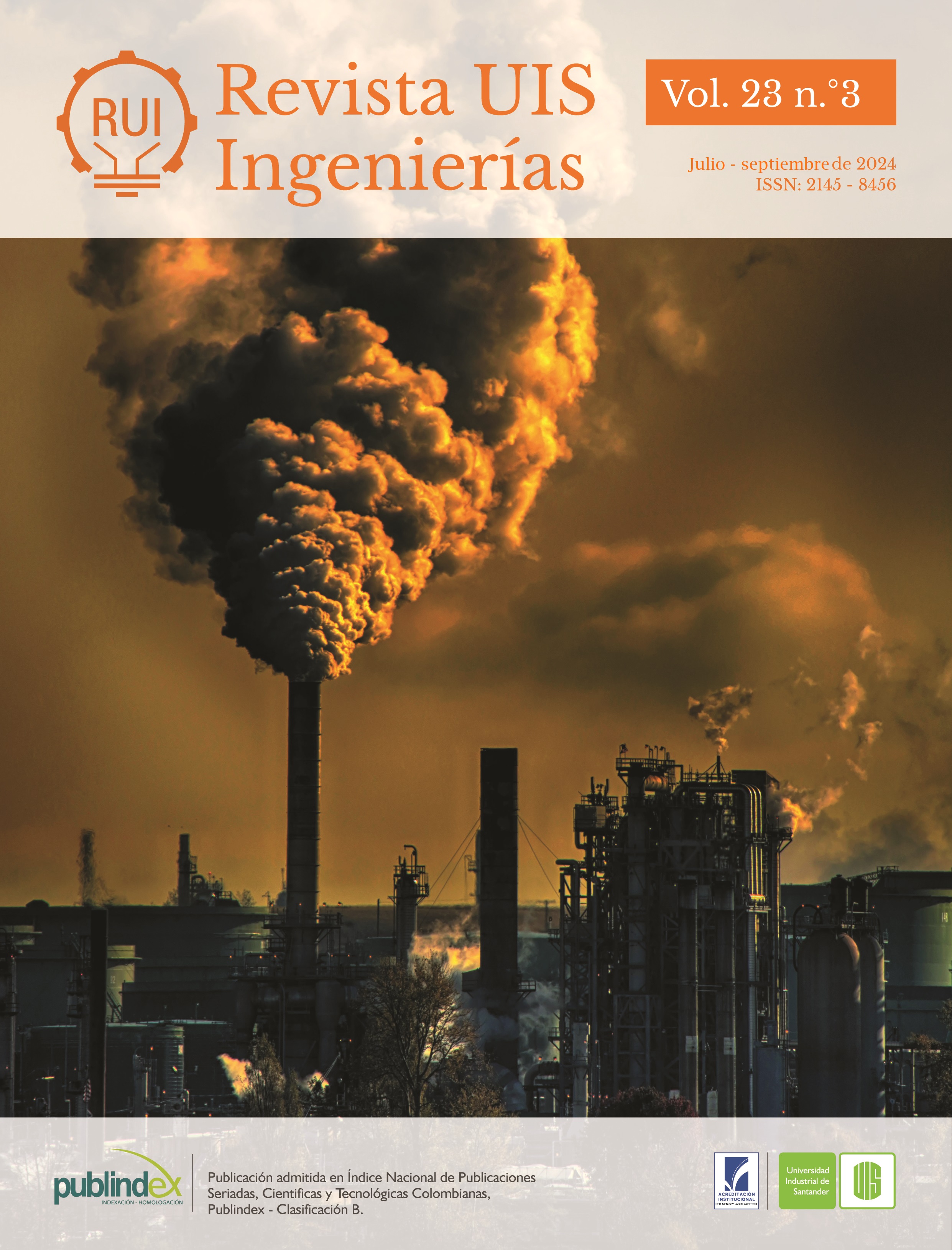Publicado 2024-08-10
Palabras clave
- metaverso,
- avatares,
- navegabilidad,
- inmersión,
- interacción
Cómo citar
Derechos de autor 2024 Revista UIS Ingenierías

Esta obra está bajo una licencia internacional Creative Commons Atribución-SinDerivadas 4.0.
Resumen
El metaverso es la próxima gran revolución de internet, permitiendo la comunicación entre usuarios desde una perspectiva virtual mapeada al mundo real. Esta tecnología ha atraído un gran interés de estudiantes, investigadores y empresas, y ha propuesto múltiples aplicaciones en sectores como educación, comercio, salud y otros. Sin embargo, su desarrollo se encuentra en sus etapas iniciales, ya que aún está en discusión cómo se estandarizará frente a las nuevas soluciones planteadas. Este artículo presenta el marco referencial de los principales componentes que conforman un metaverso (modelamiento 3D, ambiente Web 3D y aspectos de comunicación), la metodología implementada para el desarrollo del metaverso de la Escuela de Ingeniería de Sistemas y Computación – EISC Metaverse, la arquitectura, las tecnologías usadas y el prototipo desarrollado con los componentes mencionados en la revisión de la literatura, además de discutir los resultados obtenidos al desarrollar este tipo de tecnologías emergentes.
Descargas
Referencias
- S. Mirjalili, “Dragonfly algorithm: a new metaheuristic optimization technique for solving single-objective, discrete, and multi-objective problems,” Neural Comput Appl, vol.27, no.4, pp. 1053–1073, 2016,
- doi: https://doi.org/10.1007/S00521-015-1920-1
- S. Kraus, D. K. Kanbach, P. M. Krysta, M. M. Steinhoff, and N. Tomini, “Facebook and the creation of the metaverse: radical business model innovation or incremental transformation?” International Journal of
- Entrepreneurial Behavior & Research, vol. 28, no. 9, pp. 52–77, 2022, doi: https://doi.org/10.1108/IJEBR-12-2021-0984
- D. P. Barráez-Herrera, “Metaversos en el Contexto de la Educación Virtual,” Revista Tecnológica-Educativa Docentes 2.0, vol. 13, no. 1, pp. 11–19, 2022, doi: https://doi.org/10.37843/rted.v13i1.300
- D. Lulu, and Z. Zheng, “On the Translation of Metaverse,” Terminología científica y tecnológica china,
- vol. 24, no. 3, p. 49, 2022, doi: https://doi.org/10.12339/j.issn.1673-8578.2022.03.007
- H. Duan, J. Li, S. Fan, Z. Lin, X. Wu, W. Cai, “Metaverse for social good: A university campus prototype,” in Proceedings of the 29th ACM international conference on multimedia, 2021, pp. 153–161, doi: https://doi.org/10.1145/3474085.3479238
- B. Zhou, “Building a smart education ecosystem from a metaverse perspective,” Mobile Information Systems, vol. 2022, pp. 1–10, 2022, doi: https://doi.org/10.1155/2022/1938329
- F. De Felice, C. De Luca, S. Di Chiara, and A. Petrillo, “Physical and digital worlds: implications and opportunities of the metaverse,” Procedia Comput Sci, vol. 217, pp. 1744–1754, 2023, doi: https://doi.org/10.1016/j.procs.2022.12.374
- J. Smart et al., “A cross-industry public foresight project,” Proc. Metaverse Roadmap Pathways 3DWeb, pp. 1–28, 2007.
- S. M. Park and Y.-G. Kim, “A metaverse: Taxonomy, components, applications, and open challenges,” IEEE access, vol. 10, pp. 4209– 4251, 2022, doi: https://doi.org/10.1109/ACCESS.2021.3140175
- T. Türk, “The concept of metaverse, its future and its relationship with spatial information,” Advanced Geomatics, vol. 2, no. 1, pp. 17–22, 2022.
- S. Mystakidis, “Metaverse,” Encyclopedia, vol. 2, no. 1, pp. 486–497, 2022, doi: https://doi.org/10.3390/encyclopedia2010031
- J. P. A. Campos, R. Rieder, “Procedural Content Generation using Artificial Intelligence for Unique Virtual Reality Game Experiences,” 2019 Simposio sobre Realidad Virtual y Aumentada (SVR)2019, Río de Janeiro, Brasil, pp. 147-151, doi: https://doi.org/10.1109/SVR.2019.00037
- C. Andrew, Metaverse for Beginners: A Guide to Help You Learn About Metaverse, Virtual Reality and Investing in NFTs. 2022.
- J. D. N. Dionisio, W. G. B. Iii, and R. Gilbert, “3D virtual worlds and the metaverse: Current status and future possibilities,” ACM Computing Surveys (CSUR), vol. 45, no. 3, pp. 1–38, 2013, doi: https://doi.org/10.1145/2480741.2480751
- K. J. L. Nevelsteen, “Virtual world, defined from a technological perspective and applied to video games, mixed reality, and the Metaverse,” Comput Animat Virtual Worlds, vol. 29, no. 1, p. e1752, 2018, doi: https://doi.org/10.1002/CAV.1752
- Y. Zhao et al., “Metaverse: Perspectives from graphics, interactions and visualization,” Visual Informatics, vol. 6, no. 1, pp. 56–67, 2022, doi: https://doi.org/10.1016/j.visinf.2022.03.002
- A. Dudoglo and F. Ritter, Avatar Selection in the Metaverse: How users choose their digital persona in VRChat. 2022.
- A. Alvarez-Risco, S. Del-Aguila-Arcentales, M. A. Rosen, and J. A. Yáñez, “Social Cognitive Theory to Assess the Intention to participate in the Facebook Metaverse by citizens in Peru during the COVID-19 pandemic,” Journal of Open Innovation: Technology, Market, and Complexity, vol. 8, no. 3, p. 142, 2022, doi: https://doi.org/10.3390/joitmc8030142
- G. J. Hwang and S.-Y. Chien, “Definition, roles, and potential research issues of the metaverse in education: An artificial intelligence perspective,” Computers and Education: Artificial Intelligence, vol. 3, p. 100082, 2022, doi: https://doi.org/10.1016/j.caeai.2022.100082
- E. Dincelli, A. Yayla, “Immersive virtual reality in the age of the Metaverse: A hybridnarrative review based on the technology affordance perspective,” The Journal of Strategic Information Systems, vol. 31, no. 2,
- p. 101717, 2022, doi: https://doi.org/10.1016/j.jsis.2022.101717
- D. Jackson, J. Gilbert, “WebGL Specification.” Accessed: Nov. 17, 2023. [Online]. Available: https://registry.khronos.org/webgl/specs/latest/1.0/
- Y. K. Dwivedi et al., “Metaverse beyond the hype: Multidisciplinary perspectives on emerging challenges, opportunities, and agenda for research, practice and policy,” Int J Inf Manage, vol. 66, p. 102542, 2022, doi:
- https://doi.org/10.1016/j.ijinfomgt.2022.102542
- S. Mystakidis, “Metaverse,” Encyclopedia, vol. 2, no. 1, pp. 486–497, 2022.
- “DomoGallery,” [Online]. Available: https://domogallery.vercel.app/
- “Mapa de afinidad - EISC Metaverse,”. [Online]. Available: https://drive.google.com/drive/folders/1eqclHd8w6TEaaplbsfV--0jFeXLmmpml?usp=sharing
- “Proto-personas - EISC Metaverse,” [Online]. Available: https://drive.google.com/drive/folders/1gSq5JhfYLANPcY3SRwJDT-mJGyN32hd?usp=sharing
- “Mixamo,” [Online]. Available: https://www.mixamo.com/
- “EISC Metaverse,” [Online]. Available: https://eiscmetaverse.vercel.app/
- “r3f-perf – npm,” [Online]. Available: https://www.npmjs.com/package/r3f-perf

